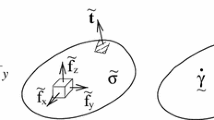Summary
Limit analysis studies the asymptotic behavior of elastic-plastic materials and structures. The asymptotic material properties exist for a class of ductile metals and are designed into optimal structural members such as I-beams and composite plates. The analysis automatically ignores the relatively small elastic deformations. Classical lower and upper bound theorems in the form of inequalities are mathematically incomplete. A duality theorem equates the greatest lower bound and the least upper bound. Although some general statement has been made on the duality relation of limit analysis, each yield criterion will lead to a specific duality theorem. The duality theorem for a class of plastic plates is established in this paper. The family of β-norms is used to represent the yield functions. Exact solutions for circular plates under a uniform load are obtained for clamped and simply supported boundaries as examples of the specific duality relations. Two classical solutions associated with Tresca and Johansen yield functions are also presented in the spirit of their own duality relations, providing interesting comparison to the new solutions. A class of approximate solutions by a finite element method is presented to show the rapid mesh convergence property of the dual formulation. Complete and general forms of the primal and dual limit analysis problems for the β-family plates are stated in terms of the components of the moment and curvature matrices.
Similar content being viewed by others
References
Hill, R.: The mathematical theory of plasticity. Oxford: Clarendon Press 1950.
Prager, W., Hodge, P. G., Jr.: Theory of perfectly plastic solids. John Wiley & Sons 1951.
Hodge, P. G., Jr.: Plastic analysis of structures. McGraw-Hill 1959.
Sokolovski, V. V.: The construction of stress and velocity fields in plastic flow problems. Inzhenernyi Zh.1 (3), 116–121 (1961).
Balmer, H. A., Doltsinis, J. St., Konig, M.: Elasto-plastic and creep analysis with the ASKA program system. Comp. Meths. Appl. Mech. Eng.3, 87–104 (1974).
Strang, G.: A mimimax problem in plasticity. In: Functional analysis and numerical analysis (Nashed, M., ed.), pp. 319–333. Springer Lecture Notes 701 (1979).
Temam, R., Strang, G.: Duality and relaxation in the variational problems of plasticity. J. Mecanique19 (3), 493–521 (1980).
Lions, J. L., Stampacchia, G.: Variational inequalities. Comm. Pure Appl. Math.20, 493–519 (1967).
Christiansen, E., Larsen, S.: Computations in limit analysis for plastic plates. International J. Num. Meth. Eng.,19, 169–184 (1983).
von Mises, R.: Göttinger Nachrichten, Math. Phys. Klasse (1913).
Fleming, W. H.: Functions with generalized gradient and generalized surfaces. Ann. Mat. Pure Appl., Series 4,44, 93–103 (1957).
Tresca, H.: Comptes Rendus Acad. Sci. Paris59 (1864).
Johansen, K. W.: Yield line theory. Original published by the Danish Cement and concrete Association, 1943, translated and published by William Clowes and Sons, London, 1962.
Yang, W. H., Young, S. L.: A finite element approach to limit solutions of plates. FENOMECH84, Stuttgart, Sept. 10–14, 1984.
Yang, W. H.: A variational principle and an algorithm for limit analysis of beams and plates. Comp. Meth. Appl. Mech. Eng.33, 575–582 (1982).
Yang, W. H.: A generalized von Mises criterion for yield and fracture. J. Appl. Mech.47, 297–300 (1980).
Isaacson, E., Keller, H.: Analysis of numerical methods. John Wiley & Sons 1966.
Drucker, D. C.: A more fundamental approach to plastic stress-strain relations. 1st U.S. Congr. Appl. Mech., pp. 487–491 (1952).
Taylor, G. I., Quinney, H.: Phil. Trans. Roy. Soc.A 230 (1931).
Hopkins, H. G., Prager, W.: The loading carrying capacity of circular plates. J. Mech. Phys. Solids2, 1–13 (1981).
Yang, W. H.: Minimization approach to limit solutions of plates. Comp. Meth. Appl. Mech. Eng.28, 265–274 (1981).
Mansfield, E. H.: Studies in collapse analysis of rigid-plastic plates with a square yield diagram. Proc. Roy. Soc. London, Ser.A241, 311–338 (1957).
Overton, M. L.: A quadratically convergent method for minimizing a sum of Euclidean norms. Mathematical Programming27, 34–63 (1983).
Author information
Authors and Affiliations
Additional information
With 6 Figures
Rights and permissions
About this article
Cite this article
Yang, W.H. A duality theorem for plastic plates. Acta Mechanica 69, 177–193 (1987). https://doi.org/10.1007/BF01175720
Received:
Issue Date:
DOI: https://doi.org/10.1007/BF01175720




